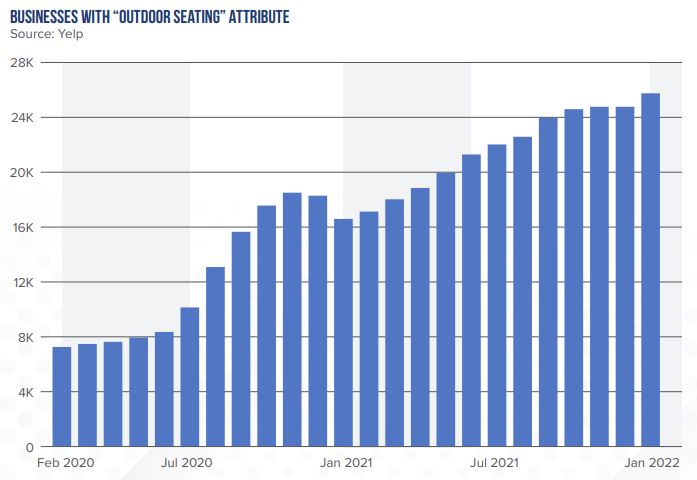The Emergence of Virtual Patios
When indoor capacity was limited throughout the pandemic, the ability to offer outdoor dining became a lifeline for many restaurants struggling to stay open. Since the COVID-19 pandemic, the implementation of outdoor patio spaces has skyrocketed, helping many businesses remain open and profitable. With the emergence of virtual patios, the restaurant industry has seen continuous market growth. There were nearly 16,500 reopenings in April 2021 alone, and roughly 6,600 new food businesses opened the following month in May.
Yelp data shows about 18,000 businesses have listed outdoor dining as an attribute, with the total number of establishments listing outdoor dining nearing 26,000. Comparatively, in February 2020, fewer than 8,000 businesses listed on Yelp included outdoor seating.

What are Virtual Patios?
As the pandemic progressed and supply chains readjusted, more materials became available, and designers learned how consumers could use the space more efficiently; consequently, these spaces evolved. A few years ago, patios were simple and merely designed with garden chairs and tables. Today, these basic structures have evolved into more sophisticated virtual patios. These features include heater sheds, foliage, chandeliers, garage doors, and more, making patios more like dining rooms.
Adapting to a New Model of Outdoor Dining
Chicago announced an expansion of a citywide outdoor dining program featuring five new outdoor dining corridors. The program helped more than 250 restaurants and bars sustain their business, and some have called to make the program permanent. Additionally, New York’s outdoor dining model, which closed off traffic to allow dining in the street, saved nearly 100,000 jobs, according to Mayor Bill de Blasio.
Between buying pop-up tents or ordering custom inflatable solutions, restaurants are spending between $1,500 to $5,000 for each four-top cost on top of heaters, misters, and cosmetic changes for outdoor dining services. Despite these costs, by simply adding an outdoor patio, restaurants are seeing an increase in gross profits by up to 65%.
How Restaurants Implement Virtual Patios
One of the most obvious renovation trends is the prioritization of safety. As new and old establishments open their doors, restaurant renovation is likewise. Many restaurants took to their creative sides and provided customers with trendy and stylish forms of outdoor dining solutions. For most, the key element to developing a new economic model required investing in their customer experience. For example, digital maturity was a big adjustment for most businesses.
A strong online-ordering presence, digital loyalty program, and robust customer relationship management system have been lifelines for restaurants during this crisis as levels of engagement across consumers soared. To extend a restaurant to include an outdoor patio or seating arrangement, it is also important to keep in mind the unpredictability of weather that may occur and cause damage.
For example, it would be smart to consider the durability of a tent or barrier before spending on these costly renovations.
The Benefits of Restaurant Renovation
The use of blockades can provide security and safety to customers, as well as protection from incoming debris, winds, or trash.
- Barriers can ideally act as sidewalk partitions and are a key feature for keeping pedestrian traffic at bay.
In recent years, many restaurants have also used commercial garage doors to open their dining rooms to the outdoors. Many are unfamiliar with them and don’t quite realize the versatility of garage doors, particularly in the commercial realm. This is considered a smart investment for customers looking to upgrade their restaurants because it can withstand harsh weather conditions. Plus, it provides a positive and healthy atmosphere to customers.
- Garage doors in outdoor dining spaces can provide customers with fresh air flow and create more open space for employees.









